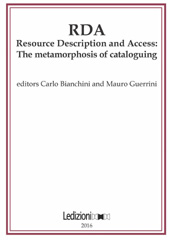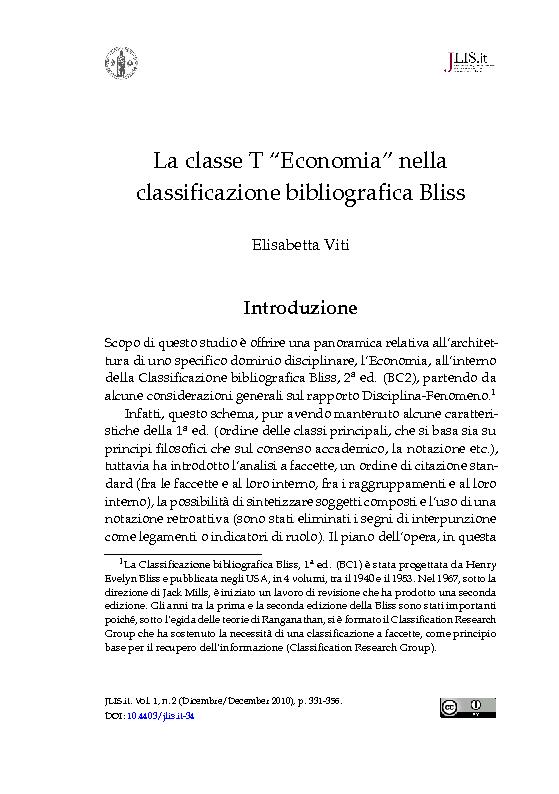Class T Economics in Bliss Bibliografic Classification
331-356 p.
Partendo da alcune considerazioni generali sul rapporto disciplina-fenomeno all'interno della Classificazione Bibliografica Bliss (2. ed.), si offre una panoramica relativa all'architettura di uno specifico dominio disciplinare: l'economia. La difficoltà a sistematizzare questa disciplina come soggetto specifico e la rapida diffusione di acronimi e nuovi termini creati per abbreviazione o per combinazione di parole già esistenti, ha portato a una drastica revisione della struttura della tavola T, Economics & Management of economic enterprise, che è attualmente organizzata in categorie, faccette e sottofaccette, le quali, per formazione di classi composte, seguono un rigoroso ordine di citazione. Il sistema prevede un ordine lineare, una notazione per mantenere l'ordine di elencazione e un indice alfabetico di tutti i termini delle tavole. La BC2 è il solo esempio di architettura classificatoria analitico-sintetica completamente faccettata, aggiornata e coerentemente sviluppata,.
ma è poco usata al di fuori dell'Inghilterra ed è ancora priva di un'interfaccia web che possa rappresentare tutte le complesse relazioni semantiche del sistema. La sua struttura ha esercitato influenze sull'informatica, testimoniate dal progetto FATKS dell'University College London, che ha studiato l'impiego delle classificazioni analitico-sintetiche come base per l'indicizzazione delle risorse digitali. Sono inoltre in atto alcune sperimentazioni che mostrano le potenzialità di conversione di questa classificazione in formato thesaurus (in particolare della classe dedicata alla musica); ed è oggetto di studio lo sviluppo di un software di generare un thesaurus dagli stessi file di input, usati per la visualizzazione della classificazione e dell'indice alfabetico. L'autrice vuole porgere un sentito ringraziamento ad Alberto Cheti, Claudio Gnoli e Anna Lucarelli per la paziente lettura e i preziosi consigli. [Testo dell'editore].
Starting from some general thoughts on the relationship discipline-phenomenon within the Bliss bibliographic classification (2. ed.), the article offers an overview of the architecture of a specific field: economics. The difficulties in systematizing the discipline, and the quick diffusion of acronyms and new definitions - created by abbreviation or combination of existing words - lead to a full structural revision of the T entry, Economics & Management of economic enterprise, that at the moment is organized into categories, facets, and subfacets, offering a strict citation order. The system has a linear order, a notation to maintain the listing order, and an alphabetic list of the terms.
BC2 is the only example of a classifying analytic-concise architecture fully faceted, updated and coherently developed, even though it is few used outside the United Kingdom, and it still lacks a web interface representing the semantic relations of the system. The influence of BC2 structure on computer science is shown by the FATKS project of the University College London, a project that studies the use of analytic-concise classification systems as the basis for digital resources indexing. Moreover, some ongoing experimentations are demonstrating the potential of this classification to be converted into a thesaurus; in addition, a software for supporting the semi-automatic generation of a thesaurus starting from the input files used for producing the classification and the alphabetic list, is under consideration. The author would thank Alberto Cheti, Claudio Gnoli and Anna Lucarelli for the precise reading and valued suggestions. [Publisher's Text].
-
Articles from the same issue (available individually)
-
Information
DOI: 10.4403/jlis.it-34
ISSN: 2038-1026
DISCIPLINES
KEYWORDS
- BC2, Classificazione bibliografica Bliss, Economia, FATKS



